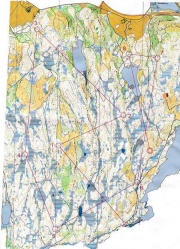Route choice testing
From O-training.net
Admin (Talk | contribs)
(Created page with '{{Orienteering exercises |Exercise Types=Route choice |Description=Course with many long legs with route choice alternatives. The time for the different routes are compared. See …')
(Created page with '{{Orienteering exercises |Exercise Types=Route choice |Description=Course with many long legs with route choice alternatives. The time for the different routes are compared. See …')
Current revision as of 12:35, 1 April 2010
Orienteering Exercise: Route choice testing
Key information
| Exercise Type: | Route choice |
|---|---|
| Target Level: | Elite level, Junior level, Intermediate level |
| Intensity: | Low, Medium, High |
| Preparation time: | Less than 5 minutes |
| OCAD Required: | No |
| Min participants: | 1 |
 | |
Course with many long legs with route choice alternatives. The time for the different routes are compared. See below for several variants. Comparing GPS tracks after the training is a very good way to evaluate the training.
| Aim: | Understand which route is fastest. Especially important to do this type of exercise in a new terrain. |
|---|---|
| Variants: | Variant A: Each runner runs the route they would like.
Variant B: The runners are asked to run specific routes Variant C: The runners run through the course several times, testing the different routes Variant D: Two/Three runners run together and always take different routes. Wait at each control and in this way see which route is the fastest. |
| Aids: | None required |
| Terrain: | A terrain in which not the straight line is always the fastest. |
| Preparations: | A course with many long legs, in which it is not very obvious which route choice is the fastest. |
| Tips: | Splits for all legs is important in the evaluation. It is also important that all runners run at the same intensity. Comparing GPS tracks after the training is a very good way to evaluate the training, especially if the physical/technical level of the runners who participate in the training varies. |
| Examples: |
Please Log in to contribute to O-training.net
O-training.net Blog articles:
- WOC Sprint Relay 2015: BIG GPS & Splits Analysis
- World Cup Long Spain: Quick GPS analysis
- WinSplits Pro for Iphone: Quick Review
- Gueorgiou: How to master the compass
- HeadCam analysis with local videos in 2DRerun
- What is effective technical training?
- RouteChoice Challenge: Long decisive leg in Swiss Champs Long
- WebRoute: Route choice leg Canada
- 2DRerun: Two very WOC Middle relevant races
- EOC Long Final: GPS Analysis
Useful links: